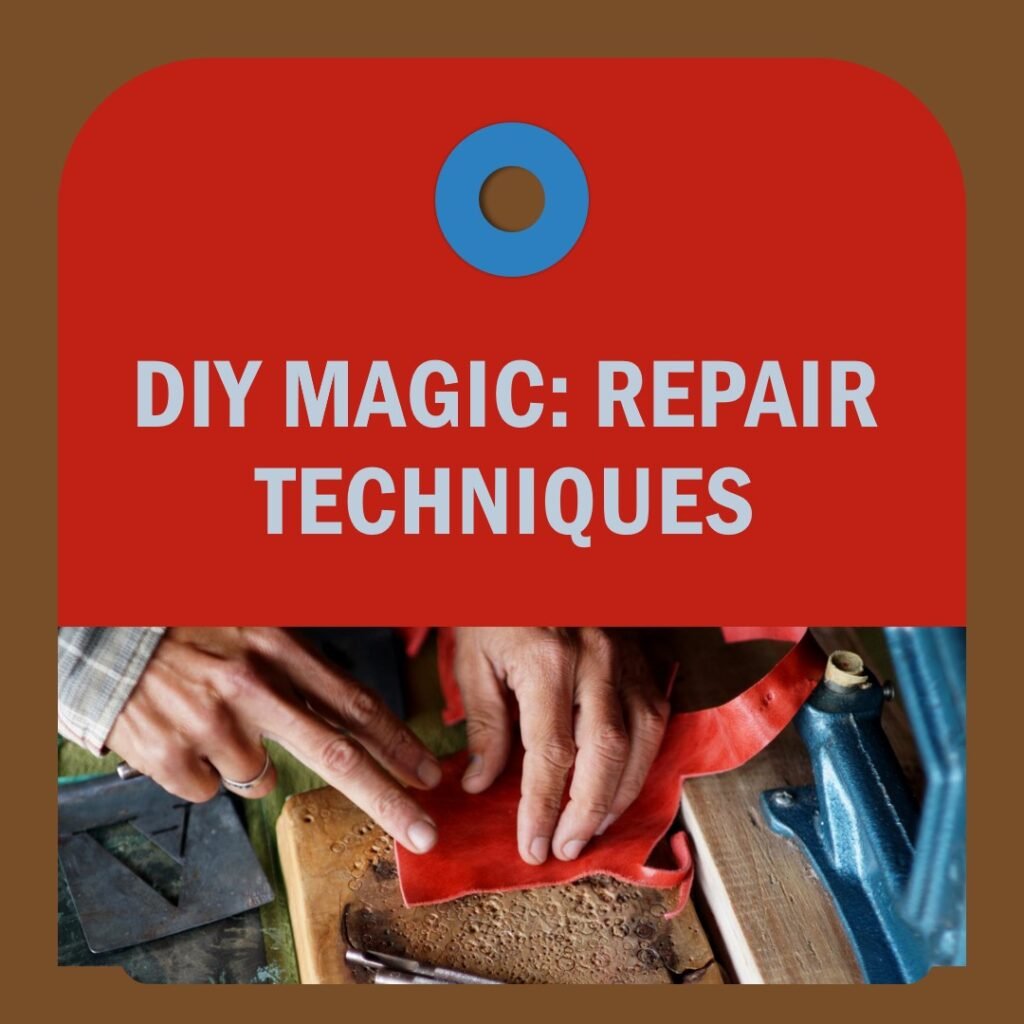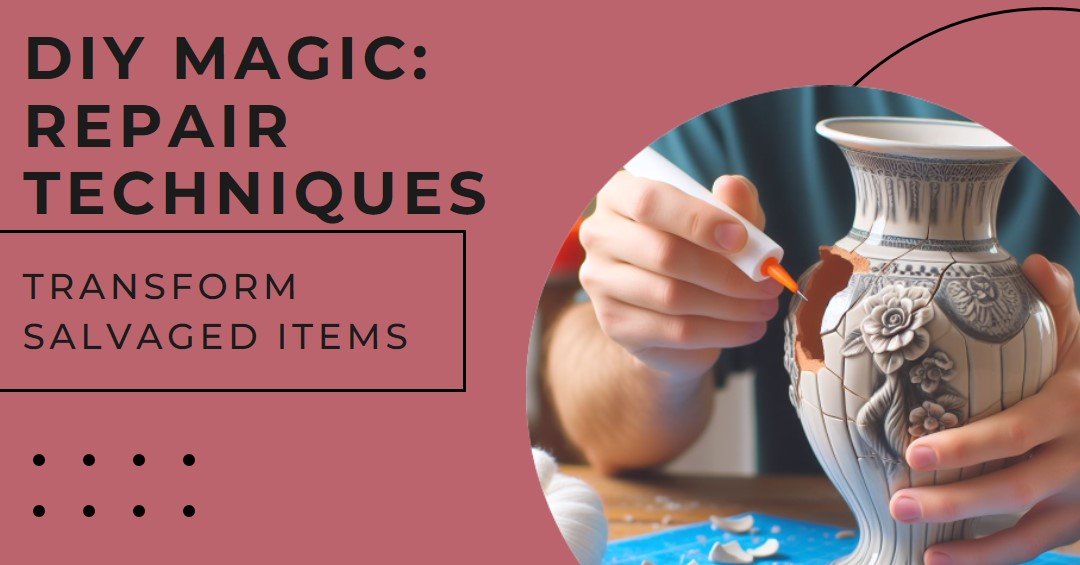Salvaging items and giving them a new life has become increasingly popular as people recognize the value of reducing waste and embracing sustainable practices. One of the key aspects of salvaging is having basic repair techniques under your belt. This allows you to revive damaged items and extend their lifespan. when you are using DIY magic for repair you can find it in dumpster diving.
By being able to repair salvaged items, you can save money by avoiding the need to purchase new replacements. In addition, you contribute to reducing waste by keeping these items out of landfills. Basic repair techniques such as sewing, gluing, and sanding can be easily learned and applied to a wide range of salvaged items, including clothing, furniture, and electronics. This empowers individuals to take control of their belongings and actively participate in the circular economy.
Why DIY magic is essential in reducing waste
DIY magic, or do-it-yourself magic, refers to the ability to transform salvaged items into desirable products through creative and innovative techniques. This approach plays a crucial role in reducing waste. By harnessing DIY magic, individuals can give a new purpose to salvaged materials and prevent them from ending up in landfills.
DIY magic encourages resourcefulness and creativity, as people find unique ways to repurpose salvaged items. Whether it’s turning old wooden pallets into stylish furniture or transforming used glass jars into chic storage containers, DIY magic unlocks the potential of discarded objects. This not only reduces waste but also adds a personal touch to one’s living space. In addition, DIY magic fosters a sense of pride in taking control of one’s environmental impact and finding sustainable solutions.
By embracing basic repair techniques and DIY magic, individuals can make a meaningful contribution to reducing waste and promoting a more sustainable future. These skills empower individuals to take ownership of their belongings, prolong the lifespan of salvaged items, and add a personal touch to their surroundings.
Essential tools for basic repairs
Various tools are essential for performing basic repair techniques on salvaged items. These tools include:
- Sewing kit: A basic sewing kit will include needles, thread, and scissors. This is necessary for repairing tears or loose seams on clothing and fabric items.
- Screwdriver set: A set of different-sized screwdrivers will come in handy for repairing furniture, electronics, and appliances.
- Glue and adhesive: Having a good-quality glue or adhesive is crucial for fixing broken items, such as ceramic or glass pieces.
- Sandpaper: Sandpaper of different grits is useful for sanding down rough surfaces or smoothing out wooden surfaces before painting or refinishing.
Recommended materials for salvaged item repairs
When it comes to salvaged item repairs, having the right materials is essential. Here are some recommended materials to have on hand:
- Thread and fabric: For clothing repairs, it’s beneficial to have a selection of thread colors that match different fabrics you may encounter.
- Wood filler: If you plan to repair wooden furniture or other wooden items, having wood filler available will help you fill in cracks and holes.
- Paint and brushes: If you need to refinish salvaged furniture or other items, having a selection of paint colors and brushes will allow you to give these items a fresh new look.
- Hardware: Keep a variety of nuts, bolts, screws, and other small hardware items on hand for repairing furniture or other items that may require replacement parts.
By having these essential tools and materials, you’ll be well-prepared to tackle basic repairs on salvaged items and give them a new lease on life.
Inspecting salvaged items for damage and functionality
When working with salvaged items, it is crucial to thoroughly inspect them for damage and functionality. This involves checking for cracks, tears, loose parts, or any other signs of wear and tear. Pay close attention to electronics and appliances to ensure they are in working condition. Take note of any missing or broken components that may need to be replaced. By conducting a thorough inspection, you can determine the extent of the repairs needed and plan accordingly.
Proper cleaning techniques for different types of salvaged items
Cleaning salvaged items is an important step in the repair process. However, it is essential to use appropriate cleaning techniques for different materials to prevent further damage. Here are some guidelines for cleaning various salvaged items:
- Clothing and fabric: Check the care labels and determine if the fabric can be machine washed or if it requires hand cleaning. Use appropriate detergents and follow the recommended cleaning instructions to avoid shrinking or discoloration.
- Wood furniture: Dust the surface using a soft cloth or vacuum with a brush attachment. Use a gentle wood cleaner or a mixture of mild soap and water to remove dirt and grime. Avoid using harsh chemicals or abrasive cleaners that can cause damage.
- Ceramic and glass items: Use a mild dish soap or a specialized ceramic/glass cleaner to clean these items. Avoid using abrasive sponges that can scratch the surface. Rinse thoroughly and dry gently with a soft cloth.
By following these cleaning techniques, you can ensure that your salvaged items are properly cleaned without causing further damage.

Repairing damaged wood salvaged items
When dealing with salvaged wood items, it is important to repair any damages to ensure their functionality and aesthetics. Here are some woodworking techniques to consider:
- Fill in cracks and gaps: Use wood filler to repair any cracks or gaps in the salvaged wood. Make sure to choose a filler that matches the color and type of wood for a seamless finish.
- Sanding: Sand the surface of the wood to remove any rough or uneven areas. Start with a coarse grit sandpaper and gradually move to finer grits for a smooth finish.
- Replacing missing parts: If the salvaged wood item has any missing parts, consider replacing them with matching wood pieces. Use appropriate woodworking techniques, such as doweling or wood joinery, to secure the new parts.
- Staining and finishing: Apply a wood stain to enhance the color and grain pattern of the salvaged wood. Once dry, apply a protective finish, such as varnish or polyurethane, to protect the wood and give it a polished look.
Restoring the beauty of wooden items through simple techniques
Restoring the beauty of wooden items can be achieved through simple techniques that bring out their natural charm. Consider the following woodworking techniques:
- Cleaning: Remove dirt and grime from the surface of the wood using a gentle cleanser or a mixture of vinegar and water. Avoid using harsh chemicals that can damage the wood.
- Sanding and refinishing: Sand the surface of the wood to remove any scratches or imperfections. Apply a fresh coat of stain or paint to revitalize the appearance of the wood.
- Repairing dents and scratches: Fill in dents and scratches with wood filler, then sand and refinish the area for a smooth and seamless finish.
- Refreshing with oil or wax: Apply a coat of wood oil or wax to nourish and protect the wood, giving it a renewed shine.
By applying these woodworking techniques, salvaged wooden items can be transformed into beautiful and functional pieces with their natural beauty restored.
Upholstery and Fabric Repair
When it comes to salvaged furniture with torn or frayed upholstery, it is crucial to repair these damages to restore the item’s functionality and appearance. The following techniques can help in this process:
- Replacing the upholstery: Remove the old, damaged upholstery and replace it with new fabric. Use suitable tools and techniques to secure the new upholstery in place, ensuring a snug fit.
- Repairing tears and frays: Mend any tears or frays in the existing upholstery using a needle and thread or fabric glue. Reinforce the repaired areas for added durability.
- Adding extra padding: If the salvaged furniture lacks sufficient padding, consider adding additional foam or batting to enhance comfort and support.
Replacing or repairing damaged fabric on salvaged clothing or accessories
Salvaged clothing or accessories may require fabric repairs to bring them back to life. Here are some techniques to consider:
- Patching holes or tears: Use fabric patches or appliques to cover and reinforce holes or tears in the fabric. Ensure that the patch matches the color and texture of the original fabric.
- Restitching seams: Repair loose or damaged seams by restitching them with a needle and thread. This will help to strengthen the fabric and prevent further damage.
- Dyeing or painting: If the salvaged fabric has stains or discolorations, consider dyeing it with fabric dye or painting it with fabric paint to achieve a refreshed and vibrant look.
By utilizing these upholstery and fabric repair techniques, salvaged items can be transformed, allowing them to be used and enjoyed for many more years to come.

Repairing dents, scratches, and rust on salvaged metal items
When it comes to salvaged metal items with dents, scratches, and rust, it is important to repair these damages to improve the aesthetics and functionality of the item. Here are some techniques to consider:
- Filling dents: Use a suitable filler material such as epoxy or solder to fill in the dented areas. Smooth out the filler and sand it down until the surface is level and matches the surrounding metal.
- Buffing out scratches: Gently sand the scratched area with fine-grit sandpaper to remove any visible scratches. Polish the surface using a metal polishing compound to restore its shine.
- Removing rust: Use a wire brush or sandpaper to remove the rust from the surface of the metal item. Apply a rust converter or primer to prevent further corrosion, then paint or coat the item to protect it from future rusting.
Restoring and polishing metal surfaces for a fresh look
To give salvaged metal items a fresh look, consider the following techniques:
- Cleaning: Use a mild soap and water solution to remove dirt, grime, and grease from the metal surfaces. Dry thoroughly to prevent any water stains.
- Polishing: Apply a metal polish or a specific polishing compound that matches the type of metal you are working with. Use a soft cloth or polishing wheel to buff the surface until it shines.
- Protecting: Apply a protective coating to prevent future tarnishing or oxidation. This could be a clear lacquer, wax, or a specialized metal sealer depending on the type of metal.
By utilizing these metalwork techniques, salvaged metal items can be restored to their former glory, adding charm and value to any space.
Basic troubleshooting and repair techniques for salvaged electronics
When it comes to salvaged electronics, it is important to have some basic troubleshooting and repair techniques in order to make them functional again. Here are some steps to consider:
- Check for loose connections: Inspect the wiring and connectors for any loose or disconnected parts. Reconnecting them properly can often solve the problem.
- Replace faulty components: If a specific component is not functioning properly, such as a resistor or capacitor, it may need to be replaced. Identify the faulty component through testing and find a suitable replacement.
- Clean circuit boards: Dust and debris can accumulate on circuit boards, causing connectivity issues. Use a soft brush or compressed air to gently clean the boards, being careful not to damage any delicate components.
- Repair or replace damaged wires: If you notice any frayed or damaged wires, they should be repaired or replaced to ensure proper electrical flow.
Safety precautions when working with electrical items
Working with salvaged electronics can be potentially dangerous if not approached with caution. Here are some safety precautions to follow:
- Turn off power: Before working on any electrical item, make sure to turn off the power source and unplug it from the outlet.
- Use insulated tools: Insulated tools help prevent electrical shocks. Make sure to use them when handling live wires or working on circuit boards.
- Wear protective gear: Always wear protective gloves and goggles to protect yourself from potential accidents or electrical shocks.
- Work in a well-ventilated area: Ensure that the area you are working in is well-ventilated to avoid the accumulation of fumes or smoke.
By following these basic troubleshooting and repair techniques and taking the necessary safety precautions, you can effectively repair salvaged electronics and bring them back to life.
Innovative ways to repurpose salvaged items beyond basic repairs
When it comes to salvaged items, there are countless creative ways to repurpose them beyond just basic repairs. Here are some innovative ideas to consider:
- Turn old electronics into unique home decor: Transform salvaged electronics, such as circuit boards or computer parts, into eye-catching wall art or desk ornaments. Get creative and think outside the box to give these items a new purpose.
- Create functional furniture: Salvaged items like old doors or window frames can be repurposed into unique furniture pieces. Turn an old door into a stylish table or repurpose window frames into decorative shelves.
- Build a garden with salvaged materials: Salvaged wood or metal can be used to create raised garden beds, planters, or garden trellises. Give your garden a unique and eco-friendly touch by repurposing salvaged materials.
- Design jewelry from old electronics: Salvage small components from old electronics, such as resistors or capacitors, and repurpose them into one-of-a-kind earrings or necklaces. Embrace the beauty of upcycling by creating stunning jewelry pieces.
Inspiring examples of DIY magic in salvaged item transformations
Seeing real-life examples of salvaged item transformations can be truly inspiring. Here are some extraordinary DIY projects that showcase the magic of repurposing salvaged materials:
| Transformation | Description |
|---|---|
| Old piano turned into a bookshelf | The wooden frame and keys of an old piano transformed into a stunning bookshelf, providing a unique storage solution for avid readers. |
| Tire swing turned into a chandelier | An old tire swing was repurposed into a whimsical chandelier, adding a touch of playfulness to any room. |
| Skateboard decks turned into wall art | Broken or worn-out skateboard decks were repurposed into colorful wall art, creating a vibrant and dynamic space. |
| Wrapping paper tubes turned into desk organizers | Empty wrapping paper tubes were repurposed into functional desk organizers, helping to keep workspace clutter-free and organized. |
These examples show the incredible potential of salvaged items and the endless possibilities for repurposing them into something beautiful and useful.
Conclusion
In conclusion, the practice of salvaging and upcycling items not only reduces waste but also fosters creativity, resourcefulness, and sustainability. By mastering basic repair techniques and embracing the magic of DIY, individuals can transform salvaged materials into new and desirable products. From furniture and decor to clothing and electronics, the possibilities for repurposing salvaged items are endless. Through these efforts, we can make a meaningful contribution to reducing waste, conserving resources, and creating a more sustainable future for generations to come. So, let’s continue to harness the power of salvaging and upcycling, turning discarded objects into treasures and inspiring others to do the same.

Greetings, eco-conscious explorers! I am Arjun Bandari, a seasoned Dumpster Diving enthusiast with over a decade of expertise in uncovering hidden treasures amidst the discarded. My journey into this unconventional lifestyle began in New York, fueled by a passion for sustainability and a desire to challenge the norms of our throwaway culture.
With a bachelor’s in Enviromental Health and Safety, I seamlessly blend academic insights with practical experiences to navigate the world of Dumpster Diving. Over the years, I’ve become a recognized figure in the sustainable living community, sharing my discoveries and insights through workshops, community outreach, and various online platforms.
My commitment to promoting eco-friendly practices has garnered attention from local and regional media, earning me featured spots in publications that highlight the environmental impact of Dumpster Diving. As an advocate for responsible waste management, I have been honored with awards recognizing my contributions to the field.
In addition to my hands-on experiences, I’ve extended my reach through various published works, shedding light on the untapped potential within discarded items. Whether it’s repurposing furniture, salvaging electronics, or sharing practical tips for fellow Dumpster Diving enthusiasts, I am dedicated to inspiring a conscious and sustainable way of living.
Join me on this exciting journey as we redefine the narrative around waste, discover hidden gems, and collectively contribute to a greener, more sustainable future. Together, let’s dive into the world of Dumpster Diving and uncover the beauty beneath the surface of our disposable society.

